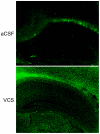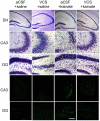Intracranial V. cholerae sialidase protects against excitotoxic neurodegeneration
- PMID: 22195039
- PMCID: PMC3240658
- DOI: 10.1371/journal.pone.0029285
Intracranial V. cholerae sialidase protects against excitotoxic neurodegeneration
Abstract
Converging evidence shows that GD3 ganglioside is a critical effector in a number of apoptotic pathways, and GM1 ganglioside has neuroprotective and noötropic properties. Targeted deletion of GD3 synthase (GD3S) eliminates GD3 and increases GM1 levels. Primary neurons from GD3S-/- mice are resistant to neurotoxicity induced by amyloid-β or hyperhomocysteinemia, and when GD3S is eliminated in the APP/PSEN1 double-transgenic model of Alzheimer's disease the plaque-associated oxidative stress and inflammatory response are absent. To date, no small-molecule inhibitor of GD3S exists. In the present study we used sialidase from Vibrio cholerae (VCS) to produce a brain ganglioside profile that approximates that of GD3S deletion. VCS hydrolyzes GD1a and complex b-series gangliosides to GM1, and the apoptogenic GD3 is degraded. VCS was infused by osmotic minipump into the dorsal third ventricle in mice over a 4-week period. Sensorimotor behaviors, anxiety, and cognition were unaffected in VCS-treated mice. To determine whether VCS was neuroprotective in vivo, we injected kainic acid on the 25th day of infusion to induce status epilepticus. Kainic acid induced a robust lesion of the CA3 hippocampal subfield in aCSF-treated controls. In contrast, all hippocampal regions in VCS-treated mice were largely intact. VCS did not protect against seizures. These results demonstrate that strategic degradation of complex gangliosides and GD3 can be used to achieve neuroprotection without adversely affecting behavior.
Conflict of interest statement
Figures







Similar articles
-
Intraventricular Sialidase Administration Enhances GM1 Ganglioside Expression and Is Partially Neuroprotective in a Mouse Model of Parkinson's Disease.PLoS One. 2015 Dec 2;10(12):e0143351. doi: 10.1371/journal.pone.0143351. eCollection 2015. PLoS One. 2015. PMID: 26629687 Free PMC article.
-
Targeted deletion of GD3 synthase protects against MPTP-induced neurodegeneration.Genes Brain Behav. 2017 Jun;16(5):522-536. doi: 10.1111/gbb.12377. Epub 2017 Apr 18. Genes Brain Behav. 2017. PMID: 28239983 Free PMC article.
-
Elimination of GD3 synthase improves memory and reduces amyloid-beta plaque load in transgenic mice.Neurobiol Aging. 2009 Nov;30(11):1777-91. doi: 10.1016/j.neurobiolaging.2007.12.022. Epub 2008 Feb 6. Neurobiol Aging. 2009. PMID: 18258340
-
GM1 Ganglioside: Past Studies and Future Potential.Mol Neurobiol. 2016 Apr;53(3):1824-1842. doi: 10.1007/s12035-015-9136-z. Epub 2015 Mar 12. Mol Neurobiol. 2016. PMID: 25762012 Review.
-
Ganglioside GD3 synthase (GD3S), a novel cancer drug target.Acta Pharm Sin B. 2018 Sep;8(5):713-720. doi: 10.1016/j.apsb.2018.07.009. Epub 2018 Jul 25. Acta Pharm Sin B. 2018. PMID: 30245960 Free PMC article. Review.
Cited by
-
Intraventricular Sialidase Administration Enhances GM1 Ganglioside Expression and Is Partially Neuroprotective in a Mouse Model of Parkinson's Disease.PLoS One. 2015 Dec 2;10(12):e0143351. doi: 10.1371/journal.pone.0143351. eCollection 2015. PLoS One. 2015. PMID: 26629687 Free PMC article.
-
Heme Oxygenase-1 May Affect Cell Signalling via Modulation of Ganglioside Composition.Oxid Med Cell Longev. 2018 Sep 19;2018:3845027. doi: 10.1155/2018/3845027. eCollection 2018. Oxid Med Cell Longev. 2018. PMID: 30327713 Free PMC article.
-
Targeted deletion of GD3 synthase protects against MPTP-induced neurodegeneration.Genes Brain Behav. 2017 Jun;16(5):522-536. doi: 10.1111/gbb.12377. Epub 2017 Apr 18. Genes Brain Behav. 2017. PMID: 28239983 Free PMC article.
-
Partial eNOS deficiency causes spontaneous thrombotic cerebral infarction, amyloid angiopathy and cognitive impairment.Mol Neurodegener. 2015 Jun 24;10:24. doi: 10.1186/s13024-015-0020-0. Mol Neurodegener. 2015. PMID: 26104027 Free PMC article.
-
Intramuscular delivery of recombinant AAV expressing EpoR76E improves memory and is neuroprotective in 5xFAD transgenics.Res Sq [Preprint]. 2025 Apr 18:rs.3.rs-6465973. doi: 10.21203/rs.3.rs-6465973/v1. Res Sq. 2025. PMID: 40321747 Free PMC article. Preprint.
References
-
- Rapport MM, Donnenfeld H, Brunner W, Hungund B, Bartfeld H. Ganglioside patterns in amyotrophic lateral sclerosis brain regions. Ann Neurol. 1985;18:60–67. - PubMed
-
- Angata T, Varki A. Chemical diversity in the sialic acids and related alpha-keto acids: an evolutionary perspective. Chem Rev. 2002;102:439–469. - PubMed
-
- De Maria R, Lenti L, Malisan F, d'Agostino F, Tomassini B, et al. Requirement for GD3 ganglioside in CD95- and ceramide-induced apoptosis. Science. 1997;277:1652–1655. - PubMed
-
- Malisan F, Testi R. Lipid signaling in CD95-mediated apoptosis. FEBS Lett. 1999;452:100–103. - PubMed
-
- Malisan F, Testi R. The ganglioside GD3 as the greek goddess Hecate: several faces turned towards as many directions. IUBMB Life. 2005;57:477–482. - PubMed
Publication types
MeSH terms
Substances
Grants and funding
LinkOut - more resources
Full Text Sources
Molecular Biology Databases
Miscellaneous

